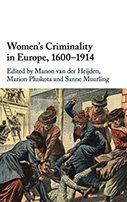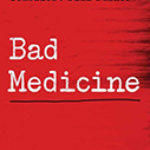Women’s Criminality In Europe, 1600-1914

Editors: Manon van der Heijden, Marion Pluskota, and Sanne Muurling
Publisher: Cambridge, UK; New York: Cambridge University Press, 2020. 270p.
Reviewer: Russ Immarigeon | September 2021
Women’s involvement with criminal activity, the criminal justice system, and imprisonment was rarely addressed before the early 1970s. As a result of accelerating academic and activist attention, however, these women are no longer ignored. But the general focus of expanded attention over recent decades has been, perhaps, too narrowly constructed. Heretofore, criminologists in particular, and even advocates for reform, have centered on the seeming contradictions and differences between women’s and men’s crimes and punishments. Women have been incarcerated less than men, for example, but when incarcerated it is for less serious offenses.
In this welcome collection of nearly a dozen articles, Leiden University historians Manon van der Heijden, Marion Pluskota, and Sanne Muurling argue that it is time to give more attention to the context, or contextualization, of women’s crimes.
As van der Heijden, Pluskota, and Muurling state more fully, “[u]nderstanding the similarities between female and male criminality is essential to avoid treating women as exceptions; the conclusions drawn from the [research in this volume] show more similarities than differences in how men and women committed a crime. By using various legal sources and including evidence of the lower courts, the studies reveal crime patterns of ordinary women in various contexts between 1600 and 1914. They demonstrate that many poor, lower-class women made choices available to them within the context of their socio-economic living conditions, opportunities and restrictions. Such options could range from using the courts to resolve violent conflicts and profiting from welfare arrangements, to stealing or choosing imprisonment as a survival strategy. Changing living standards, which were connected to employment, schooling and (institutional) welfare arrangements had a direct impact on the survival abilities of a majority of the lower-class women, their risk to become involved in crime and the likelihood to be prosecuted for it.”
In this volume, Australian, British, Belgian, and Canadian crime historians present a range of (sometimes differing) perspectives, presented in separate sections (violence, space and gender; prosecution and punishment; and representation of crime) that expand the way we look at women’s criminality and imprisonment:
- Co-editor van der Heijen examines a “model of determinants” that highlight the shifting dynamics of women’s and men’s crimes in France, England, Scotland, Germany and the Netherlands between 1600 and 1914. In the early modern period, before 1850, women’s crime rates were much higher, especially in towns and cities where their public roles were heightened because of greater family-based gender equality and female participation in the labor market. Later on, van der Heijen suggests that rising living standards and an emerging welfare state reduced women’s public criminal conduct.
- Using court-based offending, punishment and recidivism information from a medium-sized British jurisdiction between 1880 and 1905, Jo Turner (Staffordshire University) finds that episodes of female violence (e.g., common assault), especially against other women, were higher than recorded because charges were often dismissed when victims were other women; also, more women committed domestic violence against male partners than were brought to court. Possibly, too, the emergence of credible policing and the development of improved council (social) housing may have reduced the occurrence of physical conflict with one another.
- Lucy Williams and Barry Godfrey (University of Liverpool) argue that decreasing levels of so-called female criminality in London in the late 19th and early 20th centuries may be more the case that women were being diverted to other, newer state institutions (for example, from prisons and asylums to homes for the aged and inebriate reformatories); as the researchers suggest, “[l]ack of criminal convictions did not mean a lack of criminal behaviors in women nor in institutional consequences for them…rather than ‘vanishing’ altogether from the mechanisms of state discipline…certain sections of the deviant female population were simply dealt with outside of the traditional ‘penal sphere’.”
- Belgian historians Sarah Auspert, Margo De Koster, and Veerle Massin focus on long-term European perceptions about female juvenile crime over the past two centuries, including the endurance of institutional solutions, the sexualization of female deviance, the imposition of strict protective measures, the stigmatizing effects of institutionalization, and the “pathologization” of female crime; as the authors note, “[I]n most juvenile justice systems today, innovatory measures such as alternative sanctions, semi-residential and ambulatory forms of counselling remain unavailable for the ‘worst’ juvenile delinquents.”
Beyond these articles, van der Heijden, Pluskota, and Muurling have gathered others that give attention to women, violence and criminal court justice in early Bologna; the prosecution of adult men and women for adultery in Genoa (1550-1700); convict leasing systems in mid- to late-19th century England; and newspaper accounts of sexual assaults on children in 19th-century England and Wales, and of Dutch reports of intimate violence over the thirty-year period 1880-1910.
Overall, Women’s Criminality in Europe, 1600-1914 adds ably to a growing literature that includes earlier works such as van der Heijden’s Women and Crime in Early Modern Holland (Brill 2016), Pluskota’s Prostitution in Eighteenth-Century Ports (Routledge 2016), Jeanette Kamp’s Crime, Gender and Social Control in Early Modern Frankfort am Main (Brill 2019), and Ariadne Schmidt’s Prosecuting Women: A Comparative Perspective on Crime and Gender Before the Dutch Criminal Courts, 1600-1810 (Brill 2020).
Russ Immarigeon reviews books for Civic Research Institute publications covering corrections management, sexual assault, and community corrections.


